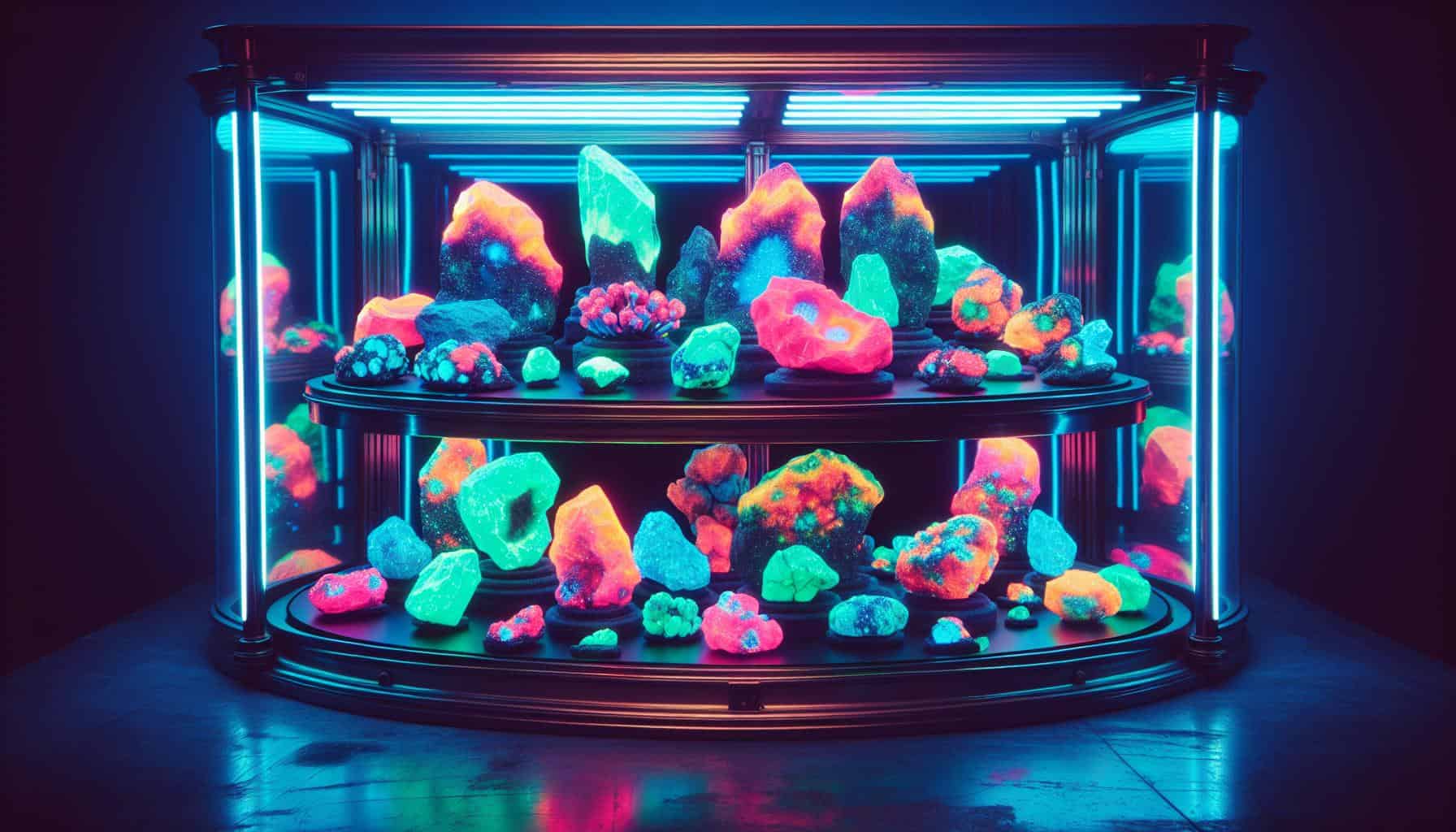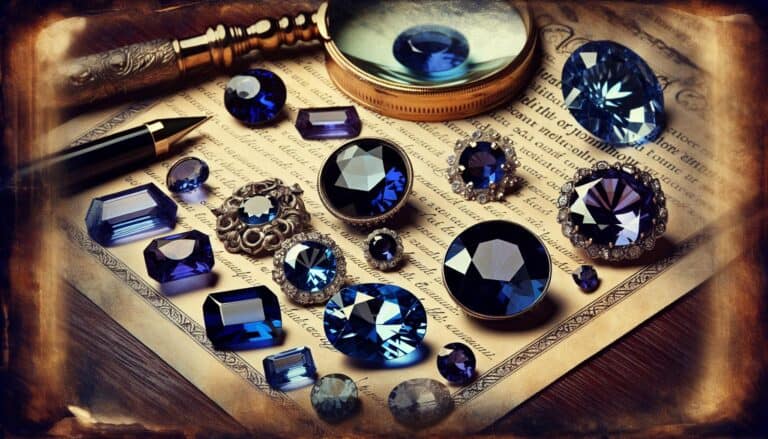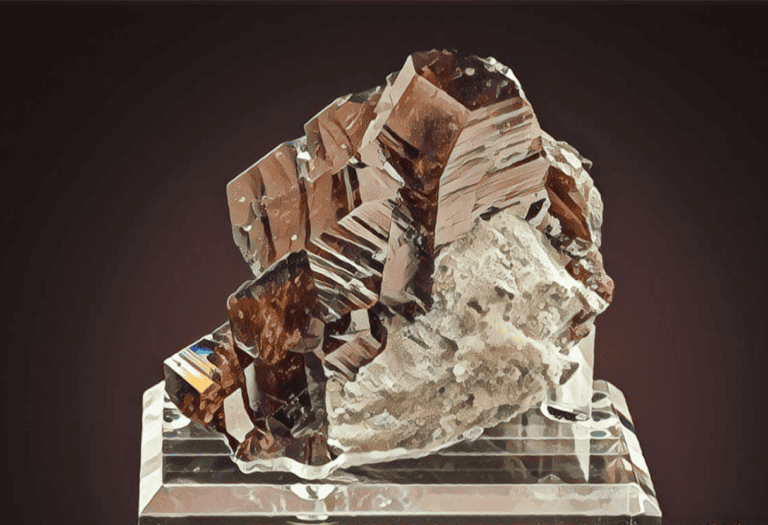Imagine stepping into a world where rocks come alive with vibrant colors under UV light, transforming a normal landscape into an ethereal glow-in-the-dark wonderland.
That’s the magic of fluorescent rocks, commonly known as glow rocks, which have captivated collectors and nature enthusiasts alike.
You’re about to dive into the fascinating realm of the best fluorescent rocks, where each stone tells a story with its unique luminescent properties.
Whether you’re an avid collector or a curious newbie, get ready to discover the most stunning glow rocks that nature has to offer.
Fluorescent rocks, or glow rocks, possess the unique ability to fluoresce under UV light, turning landscapes into ethereal wonders. Their vibrant colors and patterns, visible only under UV light, make them sought-after by collectors and enthusiasts. Understanding their characteristics and the science behind their glow enhances appreciation for these natural marvels.
What are Fluorescent Rocks?
Fluorescent rocks, also referred to as glow rocks, are a unique subset of minerals that have the ability to absorb light energy and then re-emit it, which causes them to glow. This process, known as fluorescence, occurs when certain substances are exposed to ultraviolet (UV) light, X-rays, or other forms of high-energy radiation. Due to this remarkable property, these rocks stand out among more conventional minerals, captivating a variety of enthusiasts from collectors to scientists.
You might be surprised to know that not all rocks can fluoresce. It’s a property that depends on the presence of specific minerals within the rock. Particular elements like tungsten, fluorine, and calcium often contribute to the fluorescence in these rocks. When you shine a UV light on them, these elements react by glowing in a range of breathtaking colors from bright greens and reds to deep blues and purples.
Characteristics of Fluorescent Rocks
When you’re out hunting for fluorescent rocks, keep an eye out for key characteristics:
- Vibrant colors: These are usually not visible under normal lighting conditions.
- Patterns: Some rocks may exhibit unique patterns that only become apparent when fluoresced.
- Intensity: The brightness can vary; some rocks exhibit a soft glow while others are quite vivid.
Popular Types of Fluorescent Rocks
A key to identifying the best examples of fluorescent rocks lies in knowing the most sought-after types:
- Calcite
- Willemite
- Fluorite
- Scheelite
- Opal
Each type has its own distinct glow and allure, adding to the excitement of discovering these natural wonders. Fluorite, for instance, is known for its wide range of fluorescent colors, whereas willemite tends to glow in a bright green hue.
Understanding the fundamental aspects of fluorescent rocks enhances your appreciation for them. The more you delve into their world, the more you’ll recognize how diverse and intriguing these rocks can be. Whether you’re prowling through a nighttime landscape with a UV light or examining specimens at a museum, glow rocks promise an enchanting visual experience that heightens your curiosity about the geological treasures beneath your feet.
How Do Fluorescent Rocks Glow?
When you’re delving into the world of fluorescent rocks, you might wonder how these stones manage to emit such mesmerizing glows. It’s all down to a phenomenon called fluorescence. Essentially, fluorescent minerals contain particles that can absorb ultraviolet light and instantly re-emit it at a lower energy level, creating the visible glow you see.
The Science Behind the Glow
To get technical, when you expose these rocks to UV light, the electrons in the minerals get excited to a higher energy state. As they return to their rest state, they release photons, which are just packets of light, and this is the glow you observe. The process is swift and stops once the UV source is removed, which is why the glow appears to magically disappear without the blacklight.
Types of UV light:
- Shortwave UV light: Often produces the brightest glows but requires a special lamp.
- Longwave UV light: More common and can be found in many household items, like blacklights.
Finding the Right Light
It’s important to note that not all fluorescent rocks will glow under the same type of UV light. Some minerals respond better to shortwave light, while others prefer longwave UV. For the best experience, you might need to experiment with different light sources.
Enhancing the Visual Experience
If you’re looking to bring out the best in your fluorescent rock collection:
- Use a darkened room: To experience the full effect, examine your rocks in a space with as little ambient light as possible.
- Invest in quality UV lamps: Higher-end lamps often offer more consistent and reliable illumination for your rocks.
Understanding the intricacies of fluorescence can deepen your appreciation of these natural wonders. As you explore various types of fluorescent minerals, remember that each holds a unique combination of elements that determine how and why they glow. Keep experimenting with different light sources and settings, and you’ll find that some rocks may surprise you with their hidden luminescence.
The Different Types of Fluorescent Rocks
As you delve into the world of fluorescent rocks, you’ll discover there’s a vast array of minerals that exhibit this captivating glow. Calcite is perhaps the most widespread fluorescent mineral, showing off brilliant red, blue, and sometimes even green fluorescence. Then there’s the ever-popular willemite, which can astonish you with its vibrant green glow when placed under shortwave UV light.
For those keen on a more exotic appeal, scheelite is a fascinating find, with its blue-white fluorescence that is nearly unmatched in intensity. Another noteworthy mention is fluorite, which can present a rainbow of colors under UV light – a true spectacle to witness.
Another key player in the fluorescent rock realm is autunite, a uranium phosphate mineral that glows a striking yellow-green. It serves not only as a glowing spectacle but also historically as an ore of uranium. Given its radioactive nature, it’s important to handle autunite with care.
When you’re looking into fluorescent rocks, keep in mind that the appearance of these rocks under normal light can be deceiving. Many specimens that seem mundane and lackluster in daylight can transform into intricate, vibrant displays under the glow of a UV lamp.
It’s also important to remember UV light safety when handling these rocks. Always use proper eye protection, as exposure to UV light can be harmful.
Here’s a quick reference list of some common fluorescent rocks and their typical glow colors:
- Calcite: Red, Blue, Green
- Willemite: Green
- Scheelite: Blue-White
- Fluorite: Multicolored
- Autunite: Yellow-Green
Having the right light source is crucial in observing the full potential of these glowing marvels. Each type of UV light might reveal different aspects of fluorescence in a mineral, so you might want to experiment with a variety of lighting conditions to see your collection in a new light, literally. The thrill of discovering what colors your specific rocks will emit can be an adventure in itself, fueling your passion for these natural wonders.
How to Identify and Collect Fluorescent Rocks
Embarking on a journey to discover and collect fluorescent rocks can be an exhilarating hobby. Equip yourself with a UV flashlight, ideally one that offers both shortwave and longwave light, as these wavelengths are crucial for activating the luminescent properties of various minerals. Before heading out, research your local geology or connect with mining clubs to pinpoint potential hotspots for fluorescent rock hunting.
When identifying fluorescent rocks, inspect them in a dark environment to ensure the UV light causes the minerals to glow. Some rocks display their fluorescence only under shortwave UV light, while others may show under longwave. Bear in mind that a rock’s daylight appearance can be deceptive; dull rocks might hide an electrifying luminescent heart.
Safety first: always wear protective eyewear when handling UV light to shield your eyes from potential harm. Additionally, maintain caution around rocks that could be radioactive, like autunite. Consider investing in a Geiger counter if you’re serious about your hobby, to monitor radioactivity levels and keep safe.
Once you’ve gathered your fluorescent specimens, proper storage is key. Wrap each rock in a soft cloth and store them in a sturdy container to prevent scratching and damage. Keep records of your finds, noting the location, type of UV light used, and the color of the fluorescence. Documenting these details not only assists in future identification, but also enhances the experience of your collecting journey.
Continued exploration of different locales will expand your collection with a variety of unique and vibrant fluorescent rocks. Each site visit provides new learning opportunities to refine your identification skills, as you’ll encounter minerals that challenge your knowledge and experience.
Remember, the best fluorescent rocks aren’t always the ones that shine the brightest under UV light; sometimes, it’s the subtle glow that tells the most compelling story of Earth’s incredible geological processes.
The Best Places to Find Fluorescent Rocks
Fluorescent rocks, often dubbed glow rocks, can transform your collection from the mundane to the magnificent, but you may wonder where to find these luminous treasures. While certain minerals are widely distributed, the locations where they fluoresce under UV light are more specific and often linked to particular geological formations.
For starters, consider regions known for mining activities. These areas may unearth an array of minerals, including those that exhibit fluorescence. Franklin, New Jersey, for instance, is famed for its fluorescent minerals and has been nicknamed the “Fluorescent Mineral Capital of the World.” You’ll find over 80 different fluorescent minerals here, making it an essential destination for enthusiasts.
| Notable Locations | Minerals to Find |
|---|---|
| Franklin, NJ | Calcite, Willemite, Franklinite |
| Greenland | Tugtupite |
| Langban, Sweden | Svanbergite, Calcite |
In addition to mining districts, dry desert regions like Nevada and Arizona in the United States are hot spots for fluorescent rock hunting. These areas have large deposits of opal, agate, and chalcedony that sometimes fluoresce.
Don’t overlook tailings at mines where the leftover rocks could be a potential goldmine for fluorescents. Always ensure you have permission to collect on private property or in mining operations.
Beaches and coastal areas can also yield a surprising variety of fluorescent minerals. Waves and tides often wash up interesting specimens. Hunt during the night with your UV flashlight to spot the glow emitted by these rocks and stand a better chance of adding an exceptional piece to your collection.
Lastly, turns out, your backyard or local nature trails can be potential sites to discover fluorescent rocks. Look for areas with a history of glaciation as glaciers often transport rocks over great distances, potentially depositing fluorescent minerals far from their source.
Remember, the thrill of the hunt is just as important as the find itself. There’s always another adventure waiting around the corner, and with the right equipment and a keen eye, you’re well on your way to uncovering nature’s hidden glow.
The Top 5 Fluorescent Rocks You Need in Your Collection
When you’re on the hunt for fluorescent rocks, there are a few standout specimens that’ll make your collection shine. Each of these rocks has a unique glow and history, making them not just intriguing but also conversation pieces at your next rockhound meet-up.
Calcite often tops the list as it comes in a variety of colors and is found in multiple locations around the globe. When exposed to UV light, this mineral can exhibit an incredible range of fluorescent colors from red to blue.
Another must-have is Willemite. This sought-after mineral glows in a vibrant green hue. Typically found in New Jersey, USA, Willemite’s green fluorescence is a trademark of the historic Franklin Mine.
For a bit of variety, Scheelite brings an intense blue or white glow to your collection. It’s a key mineral used in the production of tungsten and can be a beacon of light under UV. Adding Scheelite to your collection isn’t just aesthetically appealing; it’s a nod to its industrial significance.
Fluorite is renowned for its vast spectrum of fluorescent colors. Often used in fluorescence studies, its luminescent properties are unmatched. A spectrum of vibrant colors can dance across a single specimen, depending on the impurities within.
Lastly, Autunite — with its bright yellow or green fluorescence — cannot be missed. Be mindful that Autunite contains uranium, so it’s essential to handle with care and store properly.
Remember to capture the glow of these rocks under both shortwave and longwave UV lights, as their luminescence can vary dramatically. With these five spectacular additions, your fluorescent rock collection will be both diverse and impressive. As you continue to discover the wonders beneath your UV flashlight, the stories they tell and the sparkle they bring will undoubtedly enhance your rockhound experience.
How to Display and Care for Fluorescent Rocks
When you’ve amassed a collection of vibrant fluorescent rocks, displaying them properly can elevate their beauty and protect their unique characteristics. UV display cases are an excellent choice to showcase your glow rocks. These cases often come with built-in shortwave and longwave UV lights that can bring out the brilliant colors of your specimens. Ensure the UV source is strong enough to highlight the rocks’ features without overheating, which could damage the minerals.
Rotating displays are another popular choice, allowing viewers to appreciate the full spectrum of colors and patterns from all angles. Moreover, integrating mirrored backdrops can enhance the fluorescent effect, creating a stunning visual display that captures everyone’s attention.
In caring for your fluorescent rocks, bear in mind the importance of environmental control. Extreme temperatures and humidity can cause minerals to fracture or lose their luster. Strive to keep your collection in a climate-controlled environment where temperature and humidity levels are stable.
For cleaning, use a soft brush or a damp cloth to delicately remove any dust or dirt from the surface of the rocks. Refrain from using harsh chemicals or abrasive cleaning methods that might scratch or damage the minerals.
Additionally, be mindful of the storage materials used. Acid-free containers and display mounts are essential to prevent any chemical reactions that could alter the appearance of your glow rocks.
Finally, consider keeping a detailed catalog of your collection. Note the name, provenance, and any interesting features or historical data about each piece. Not only does this serve as a reference for you, but it’s also valuable for any future collectors who may inherit or acquire your specimens.
By displaying your fluorescent rocks effectively and following proper care guidelines, you’ll ensure that your collection remains a source of fascination for years to come. Enjoy the mesmerizing colors and rich history embedded within each stone as you dive deeper into the luminous world of glow rocks.
Conclusion on Glowing Rocks
Dive into the world of fluorescent rocks and let your collection shine.
With the right UV display cases and thoughtful environmental control, you’ll preserve the dazzling beauty of your glow rocks for years to come. Remember, a gentle touch when cleaning and proper storage are key to maintaining their splendor. As you curate and catalog your radiant treasures, you’re not just a collector; you’re a guardian of geological history.
Embrace the glow, and let your passion for these natural wonders illuminate your journey.







